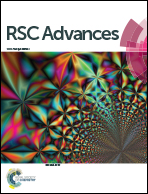Preparation of pH- and magnetism-responsive sodium alginate/Fe3O4@HNTs nanocomposite beads for controlled release of granulysin
Abstract
The burst release of drug molecules from natural biopolymer-based hydrogels is a common issue in the field of controlled drug delivery systems. pH- and magnetism-responsive sodium alginate/Fe3O4@HNTs nanocomposite beads for controlled release of granulysin were prepared. Fe3O4@HNTs were prepared by growth of Fe3O4 nanoparticles on the surface of HNTs via solvothermal reactions. Then, the SA/Fe3O4@HNTs-granulysin nanocomposite beads were prepared by sol–gel transition of the SA-granulysin aqueous solution with homogeneously dispersed Fe3O4@HNTs. The nanocomposite beads were characterized by Fourier transform infrared spectroscopy and scanning electron microscopy. In addition, the factors, e.g., the concentration of SA, weight ratio of Fe3O4@HNTs to SA and weight ratio of FeCl3·6H2O to HNTs, influencing granulysin loading and controlled release behavior were systematically studied. The entrapment efficiency was enhanced to 61.4% and the burst release of granulysin was overcome by introducing appropriate amounts of HNTs and the Fe3O4 nanoparticles. Granulysin was released at a steady rate in pH 7.4 PB owing to the synergistic effects of SA, HNTs and the Fe3O4 nanoparticles. The release kinetics of granulysin from the nanocomposite beads follows the Higuchi model. HNTs and the Fe3O4 nanoparticles formed additional crosslinkages in the nanocomposite beads, which changed the swelling behaviors of the beads, and then improved the controlled release behaviors of the model drug molecules.


 Please wait while we load your content...
Please wait while we load your content...